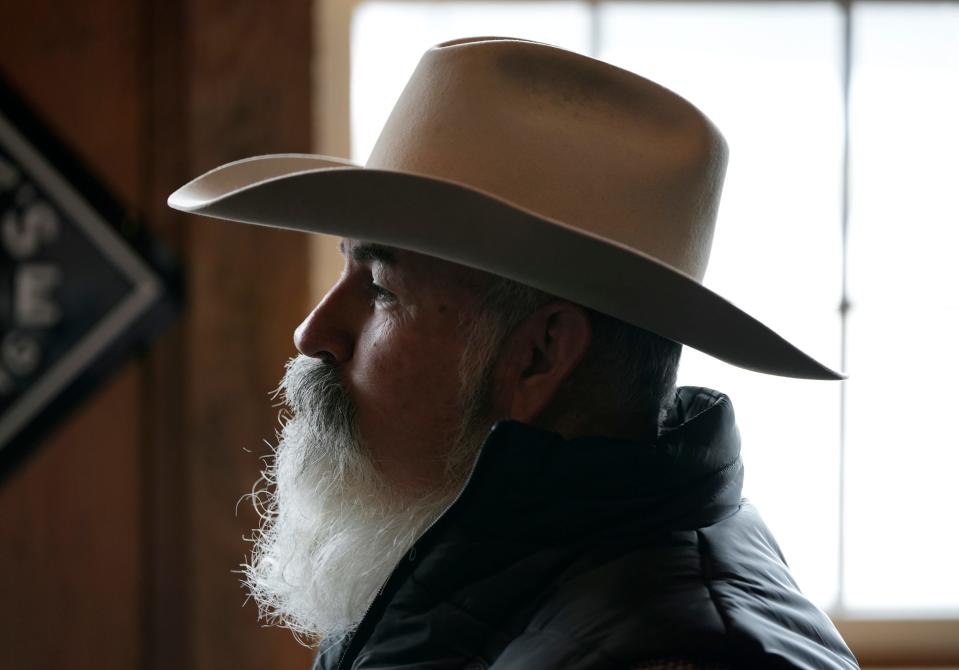Dead heat Senate race and not-so-heated race for governor, poll shows

- Oops!Something went wrong.Please try again later.
- Oops!Something went wrong.Please try again later.
- Oops!Something went wrong.Please try again later.
- Oops!Something went wrong.Please try again later.
We're less than two months out from the election, and a new poll released this week offered some hints about where the game stands.
Ohio's U.S. Senate race between J.D. Vance and U.S. Rep. Tim Ryan remains essentially tied, according to the USA TODAY Network Ohio/Suffolk University poll of likely Ohio voters. Ryan maintained a small lead with 46.6% compared to 45.6% of voters who planned to support Vance, which was within the poll's margin of error. Roughly 6% of voters were undecided.
Ryan has spent most of his campaign targeting independent voters, and he continues to do well with that voting bloc, the survey found. Vance improved his numbers with independents and people of color, and he's also more popular with Ohioans who are concerned about the economy. That's good news for him; the economy is still the top issue on the minds of voters.
The poll, conducted earlier this month, came after Ryan used his fundraising advantage to dominate the airwaves all summer. Vance and his allies are just now starting to ramp up spending, so we'll see if he can widen the gap in the coming weeks.
The governor's race, meanwhile, is less of a nail-biter. Gov. Mike DeWine led former Dayton Mayor Nan Whaley 53.8% to 39.2%, and DeWine won over some Democrats while maintaining an advantage with independents. He also grabbed 93% of Republicans despite frustration within his party over his COVID-19 response.
Abortion became a big part of Whaley's campaign after the U.S. Supreme Court struck down Roe v. Wade in June. And she's right that Ohio's abortion restrictions are unpopular: 68% of voters opposed the six-week abortion ban signed into law by DeWine. For whatever reason, though, Whaley doesn't appear to be capitalizing on that frustration.
What you need to know about Supreme Court races
The races for governor and Senate are getting a ton of attention, but they aren't the only important statewide elections this year. Perhaps the most underrated and significant of them all: state Supreme Court.
I brought in Laura Bischoff to explain why.
How many seats are up on the court this year? Who's running?
LB: The chief justice job is open for the first time since 2011. Republican Maureen O'Connor, who has served in statewide office longer than any woman in state history, can't run for reelection as chief due to age limits. Justices Sharon Kennedy, a Republican, and Jennifer Brunner, a Democrat, are running to replace her.
Two other seats are up for grabs. Democrats Marilyn Zayas and Terri Jamison − both appellate court judges − are trying to unseat Justices Pat DeWine and Pat Fischer, two Cincinnati Republicans.
If Zayas beats DeWine, she'll be the first Latina on the court. If Jamison wins, she'll be the third Black woman on the court.
Why do these races matter?
LB: Supreme Court decisions impact how much Ohioans pay in taxes, whether utility companies can add fees to ratepayers' bills, how insurance and business laws are interpreted, what government records will be available to the public and more. The court also plays an enormous role in ruling whether legislative and congressional maps created by the Ohio Redistricting Commission are constitutional.
In a post-Roe world, and after the state's messy redistricting process, do you think voters are paying more attention to these races?
LB: After living through the Dobbs decision and redistricting fights this year, Ohio voters recognize how important Supreme Court seats are. This is a big change, because in the past, a lot of voters just picked names that sounded good, without really knowing the candidates' views. The battle over political maps will continue at the court next year. Democrats have a chance to take control over the Supreme Court for the first time since 1986. And Jennifer Brunner, if she defeats her Republican colleague Sharon Kennedy, would be the first Democrat to be chief justice since Frank Celebrezze held the job between 1978 and 1986.

Remember Joe Blystone?
It's hard to forget the cowboy hat-wearing Republican who challenged DeWine for governor in the May primary. He ran as an outsider candidate and came in third place after blasting DeWine's COVID-19 response and peddling false claims about the 2020 election.
Now, it looks like he might be in trouble.
Secretary of State Frank LaRose said last week that Blystone's campaign finance violations were egregious enough to warrant criminal prosecution. As Jessie Balmert previously reported, Blystone's campaign collected $101,000 in cash donations exceeding $100, which is a no-no. He also reported contributions from corporations, which can't donate to individuals running for office.
The Ohio Elections Commission will meet in December to discuss Blystone's potential violations and go from there.
Questions or story ideas? Email me at hbemiller@dispatch.com. You can find me on Twitter @haleybemiller.
Check out the latest episode of Ohio Politics Explained and tune in for a new episode on Friday. You can subscribe through Apple, Spotify or wherever you get your podcasts.
This article originally appeared on The Columbus Dispatch: Dead heat Senate race and not-so-heated race for governor, poll shows

